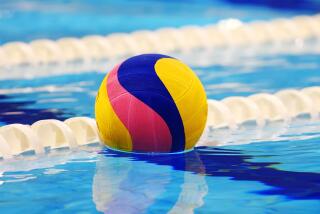Competition for O.C. Pool Access Gets More Heated
It is a quintessentially Southern California tale, this struggle over water rights.
But instead of developers fighting farmers for the precious liquid, growing numbers of fitness enthusiasts, youth swimmers and water-polo players are battling to see who gets their feet wet first and for how long.
Because the number of pools being built for competitive programs has lagged far behind the demand, youth swim teams across the Southland increasingly are turning to homeowners associations in upscale suburban developments, often tying up community pools during prime hours.
That hasn’t always sat well with dues-paying association members.
In the Canyon Crest enclave of Mission Viejo, a handful of lap swimmers a few years ago circulated petitions forcing the homeowners association board to move the youth team workouts from the more desirable mornings to the afternoons. Even though the practice times were changed, if someone wants to swim laps today, the team, in most cases, must give up a lane.
At the Harbor View Homes community in Newport Beach, UC Irvine swim coach and aquatics director Charlie Schober has watched tensions build over the last eight summers he has coached the neighborhood swim team.
“Community members were concerned they wouldn’t have enough time in the pool,” Schober said. “The problem is [that] it’s not a backyard pool that belongs to any one person.”
And in Irvine’s oh-so-genteel Turtle Rock area, where community pools and shared recreational facilities were intended as neighborhood glue, one resident has sued, complaining that the Turtle Rock Sharks’ practices make it difficult for her to swim laps during the summer.
Petty? Some have said so, especially the poolside parents of future Olympians. But when homeowners pay big bucks for such recreational facilities, is it unreasonable for them to expect their time in the water?
“With these types of private facilities, people are very possessive,” said Ken Willis, president of the League of California Homeowners. “It’s conceivable that in making such decisions, you make a decision that imposes on the freedom of dues-paying members.”
In Los Angeles’ 55 city-operated pools, too many people routinely compete to swim during the same hours. Complaints, if not lawsuits, arise when people think there are too few lanes open for laps, or when an oblivious young swimmer strays into the lap area and collides with an adult.
“With so little water and so many users, it’s kind of like the Serengeti watering hole in the middle of the drought season,” said John Vowels, Los Angeles’ principal recreation supervisor for aquatics. “You have the crocodile, the lion and the zebra all competing to have a drink of water. It’s total friction.”
Still, those conflicts don’t reach the same pitch as those over other pools, in part because only a fifth of Los Angeles municipal pools are open year-round, and many weren’t made for competitive swimming.
Growth of Swim Clubs a Contributing Factor
The backbone of competitive swimming is formed by private swim clubs, which start kids swimming in preschool and turn them into Olympians in their teens. Across suburban Southern California, youth swimming can take on big-league stakes as kids struggle out of bed while it’s still dark to swim thousands of meters, chasing dreams of a gold medal.
Since 1985, the number of people involved in elite swim-club programs has jumped from less than 7,000 to at least 17,000, said Mary Jo Swalley, executive director of Southern California Swimming in Santa Barbara, which governs the sport in the region. Another 10,000 to 20,000 swim in summer leagues.
With more kids involved in more activities crowding the region’s pools, there are “a lot of teams that can’t take more athletes because they don’t have any place for them to practice,” Swalley said.
The problem is a regional one, but conflicts are heightened in more recently developed areas where homeowners associations are plentiful. In Orange County, which spawned champions Greg Louganis, Janet Evans and Amanda Beard, competition is particular keen, as is the struggle for water time.
“When it comes to swimming, Orange County’s a whole different level of interest and quality,” said Diego Olivieri, aquatics director for the Central Orange Coast YMCA in Newport Beach, whose pool is in big demand.
In the past, swim clubs could depend on high school pools--both in older urban areas and across suburbia. Nowadays, Swalley said, those facilities are crowded year-round with their own teams--men’s water polo in the fall, women’s water polo in the winter and swimming in the spring.
“There’s just greater demand for pool time than there was before,” said longtime UC Irvine water-polo coach Edward Newland. “Not just community pools--at college pools, high school pools. It’s everywhere.”
Swim experts say the astonishing growth of women’s water polo has exacerbated the shortage.
The number of women’s high school water-polo teams in Southern California has grown about 80% since the California Interscholastic Federation sanctioned competition two years ago, said Thom Simmons, sports information director of the CIF’s Southern Section.
With the high school water-polo teams come the club teams that feed them and develop players. Newland said there are so many water-polo players in Newport Beach and Corona del Mar that it is often “a mob sene.”
Pools are “just jammed all the time with kids,” he said. “It’s very socially in in Newport Beach to have your kid play water polo.”
That has consequences for everyone else trying to get into a pool.
Just recently, one of Orange County’s best-known swim clubs, the Mission Viejo Nadadores, with more than 600 swimmers, was bumped from Mission Viejo High School for at least the next two or three months, said coach Bill Rose, because the girls in the school’s water-polo program needed to practice. The club will continue to use the Mission Viejo Marguerite Swim Complex, doubling up the number of swimmers in each lane.
Several swim coaches said they are forced to use the homeowners association pools because of the way planned communities such as Irvine are built. When it comes to constructing athletic facilities in a new development, clearing the land and planting grass for a soccer field or baseball diamond is a lot cheaper than building and keeping up a swimming pool.
Instead of the city building community pools, Irvine has relied on the homeowners associations to do it.
“We do what a city would normally have to do with its facilities,” said Dave Salo, head coach of the Irvine Novaquatics. “We provide the coaching and the staffing, which eliminates the need for the community or city to provide that.”
Irvine’s Shortage About to Intensify
Pool pressure could get worse in Irvine when the only city-owned pools--the three at Heritage Park--are closed for renovation in the next year or so.
More than 10 teams swim at Heritage Park, where pools are nearly always filled.
City officials hope that during the 15 to 18 months the Heritage Park pools are closed to upgrade them for disabled access, other facilities, such as the YMCA and homeowners associations, can fill the gap.
One Turtle Rock pool already is taken, however, which has led to a competition more heated than any of the swim meets. This one has been unfolding daily since March 31 in a Santa Ana courtroom, where a Superior Court judge soon will rule.
Alisa Ross sued the Turtle Rock Park and Recreation Assn., alleging that the community’s 120-member youth swim team monopolizes the pool. Her suit also seeks to protect homeowners from a lawsuit should one of the team members get injured during practice.
The association disputes the claim, noting that the Sharks use only one of three Turtle Rock pools for only a limited number of hours about 10 weeks during the summer.
Association President Charles H. Oliver has said that the team uses the 25-yard junior-Olympic-sized pool and four of its six lanes four days a week from 3 to 6 p.m., as well as two hours during the morning three times a week. On selected Saturdays, the team uses the entire pool from 8 a.m. to 1 p.m.
But Ross and others contend that the two lanes team members leave open don’t allow other swimmers enough room. They also say that the other options are a tots’ wading pool and an unheated deep-water diving pool.
Ross has complained of threatening telephone calls and eggs thrown at her car when she tried to run for a position on the homeowners association board in 1997.
In November, someone wrote an anonymous letter to The Times warning that he or she would pour caustic chemicals into the pool. “Unfortunately, some casualties will also be affected by the chemicals,” the letter said. “For those necessary casualties, I will be sorry.”
The threat never was carried out, and Irvine police never found the writer.
Swim Programs Forced to Reduce Training
Coaches say that restricting training, as they’ve had to do because of the demand for pool time, can slow a swimmer’s development.
“Most competitive aquatics programs do two workouts a day,” said Erik Terry, athletic director at Irvine High School, which has turned out world-class swimmers and water-polo players, including Atlanta Olympic gold-medalist Amanda Beard.
Only University High has its own pool. Irvine High swimmers must vie for time at the Heritage Park complex with Woodbridge and Northwood high schools.
“Because so many people want to use the pool, we’ve had to cut down to one workout,” Terry said. “When Heritage Park closes down, we’re going to be at a loss as to where to relocate our swimmers and water-polo athletes.”
Is there a solution to such escalating demand? Building more pools is one way, but they are very expensive. Even when their construction has been underwritten for major competitions, upkeep has strained the budgets in some cities, including Seattle.
In the meantime, conflict over too many people trying to use too few pools is likely to intensify across the Southland. Whatever the judge’s decision in Ross’ suit, local swim-club supporters believe children should have the chance to develop.
“These people have a right to complain,” agreed Jim Lessee, president of the Irvine Swim League, of which the Turtle Rock Sharks is a member. “But they . . . have to look into their own hearts, and maybe have to give up a little for the greater good.”
Staff writers Kate Folmar and Sandy Yang and correspondent Eric C Sanitate contributed to this report.




